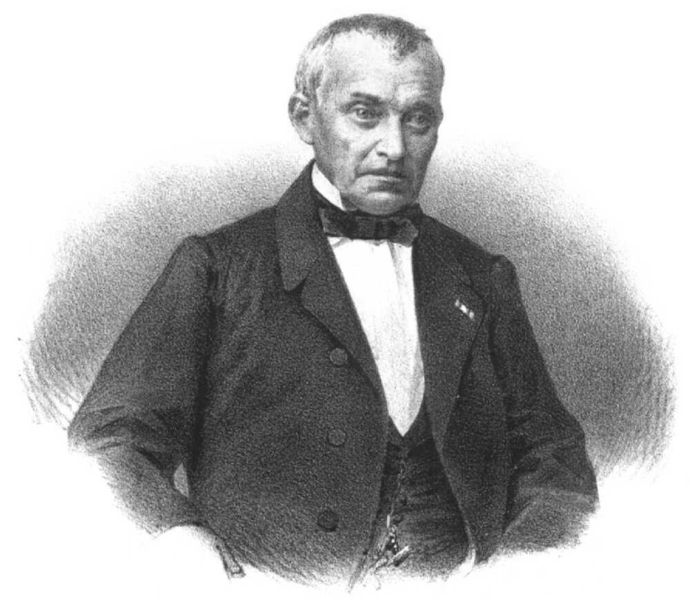<Back to Index>
- Astronomer Johann Heinrich von Mädler, 1794
- Writer Terence Hanbury White, 1906
- Minister of Religion and Education Albert Apponyi de Nagyappony, 1846
PAGE SPONSOR

Johann Heinrich von Mädler (May 29, 1794 – March 14, 1874) was a German astronomer.
He was orphaned at age 19 by an outbreak of typhus, and found himself responsible for raising three younger sisters. He began giving academic lessons as a private tutor and in this way met Wilhelm Beer, a wealthy banker in 1824.
In 1829 Beer decided to set up a private observatory with a 95 mm refractor telescope made by Joseph von Fraunhofer, and Mädler worked there. In 1830 they began producing drawings of Mars which later became the first true maps of that planet. They were the first to choose what is today known as Sinus Meridiani as the prime meridian for Mars maps.
They made a preliminary determination for Mars' rotation period, which was off by almost 13 seconds. A later determination in 1837 was off by only 1.1 seconds.
They also produced the first exact map of the Moon, Mappa Selenographica, published in four volumes in 1834 – 1836. In 1837 a description of the Moon (Der Mond) was published. Both were the best descriptions of the Moon for many decades, not superseded until the map of Johann Friedrich Julius Schmidt in the 1870s. Beer and Mädler drew the firm conclusion that the features on the Moon do not change, and there is no atmosphere or water.
In 1836, Johann Franz Encke appointed Mädler an observer at the Berlin Observatory, and he observed with its 240 mm refractor. In 1840, Mädler was appointed director of the Dorpat (Tartu) Observatory in Estonia, succeeding Friedrich Wilhelm Struve who had moved to Pulkovo Observatory. He carried out meteorological as well as astronomical observations. He continued Struve's observations of double stars. He remained in Tartu until he retired in 1865, and then returned to Germany.
By examining the proper motions of stars, he came up with his "Central Sun Hypothesis", according to which the center of the galaxy was located in the Pleiades star cluster and that the Sun revolves around it. He got the location wrong.
He published many scientific works, among the two volume History of Descriptive Astronomy in 1873.
Notwithstanding
several singular scientific errors, J.H. von Mädler is without
doubt, one of the great and eminent astronomers of the 19th century. The craters Mädler on the Moon and Mädler on Mars are both named in his honor. Next to his other numerous and important works, von Mädler made calculations concerning the true length of the tropical year with
precisions never attained before, though this fact is little known.
Based on his results, he made novel calendar proposals to Russia, which at this time used the conventional tropic year according to Sosigenes of Alexandria of exactly 365 days 6 hours. Neither the Tsar nor the Orthodox clergy accepted this unsolicited proposal. After the Bolshevik Revolution in Russia, Lenin adopted the western (papal) calendar, with its conventional tropic year of 365.2425 days (i.e. 365d. 5h 49min. 12s) due to Christopher Clavius (1537 - 1612). But this was astronomically true about 6000 years ago. The conventional tropical year according to Simon Newcomb (1835 - 1909) was
365.2422 days (= 365d. 5h 48min. 46.08s). But this is no more than
an approximate value. The real tropical year 2000.0 (measured by Pierre
Bretagnon) was 365.242190517 days, that is about 365d. 5h 48min.
45.26s. That is also very close to the conventional tropic year
according to von Mädler: 36531⁄128 or
365.2421875 days, exactly 365d. 5h 48min. and 45s or 365d. 6h. minus
11min 15s. But because the real tropical year shortens about half a
second per century, this will exactly attain the von Mädler
proposed value in only a few decades. Thus, we can well expect that yet
we can count on the conventional tropic year according to von Mädler.